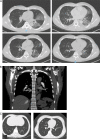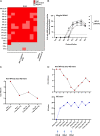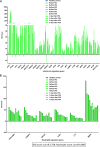Preexisting autoantibodies to type I IFNs underlie critical COVID-19 pneumonia in patients with APS-1
- PMID: 33890986
- PMCID: PMC8077172
- DOI: 10.1084/jem.20210554
Preexisting autoantibodies to type I IFNs underlie critical COVID-19 pneumonia in patients with APS-1
Abstract
Patients with biallelic loss-of-function variants of AIRE suffer from autoimmune polyendocrine syndrome type-1 (APS-1) and produce a broad range of autoantibodies (auto-Abs), including circulating auto-Abs neutralizing most type I interferons (IFNs). These auto-Abs were recently reported to account for at least 10% of cases of life-threatening COVID-19 pneumonia in the general population. We report 22 APS-1 patients from 21 kindreds in seven countries, aged between 8 and 48 yr and infected with SARS-CoV-2 since February 2020. The 21 patients tested had auto-Abs neutralizing IFN-α subtypes and/or IFN-ω; one had anti-IFN-β and another anti-IFN-ε, but none had anti-IFN-κ. Strikingly, 19 patients (86%) were hospitalized for COVID-19 pneumonia, including 15 (68%) admitted to an intensive care unit, 11 (50%) who required mechanical ventilation, and four (18%) who died. Ambulatory disease in three patients (14%) was possibly accounted for by prior or early specific interventions. Preexisting auto-Abs neutralizing type I IFNs in APS-1 patients confer a very high risk of life-threatening COVID-19 pneumonia at any age.
© 2021 Bastard et al.
Conflict of interest statement
Disclosures: P.D. Burbelo reported US Patent no. 10,564,152 issued. J.C. Casanova reported a patent to 63/055,155 pending and a patent to 63/141,669 pending. No other disclosures were reported.
Figures




References
-
- Bastard, P., Rosen L.B., Zhang Q., Michailidis E., Hoffmann H.H., Zhang Y., Dorgham K., Philippot Q., Rosain J., Béziat V., et al. . COVID Human Genetic Effort . 2020. Autoantibodies against type I IFNs in patients with life-threatening COVID-19. Science. 370:eabd4585. 10.1126/science.abd4585 - DOI - PMC - PubMed
-
- Bastard, P., Michailidis E., Hoffmann H.H., Chbihi M., Le Voyer T., Rosain J., Philippot Q., Seeleuthner Y., Gervais A., Materna M., et al. . 2021c. Auto-antibodies to type I IFNs can underlie adverse reactions to yellow fever live attenuated vaccine. J. Exp. Med. 218:e20202486. 10.1084/jem.20202486 - DOI - PMC - PubMed
Publication types
MeSH terms
Substances
Supplementary concepts
Grants and funding
LinkOut - more resources
Full Text Sources
Other Literature Sources
Medical
Miscellaneous

